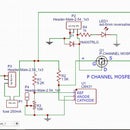Introduction: EMF Detector 0- 999 Hz for ATtiny 85
An EMF meter can measure AC electromagnetic fields, which are usually emitted from manmade sources such as electrical wiring, while gauss meters or magnetometers measure DC fields, which occur naturally in Earth's geomagnetic field and are emitted from other sources where direct current is present.
First a BIG thank you to the Arduino open Source community where I learned in record time how to.
Due to sharing, the internet and many websites and electronic clubs, it was possible to pick up my hobby again where I left off and re-learn within just over 2 years.
This instructable is Inspire by Khaleel123 and here describing how I made my own version.
Make your own EMF meter
WHAT IS EMF
EMF measurements are measurements of ambient (surrounding) electromagnetic fields that are performed using probes. These probes can be generally considered as antennas although with different characteristics. In fact, probes should not perturb the electromagnetic field and must prevent coupling and reflection as much as possible in order to obtain precise results.
As we are also detecting 240 VOLT inside walls and 50 Hz it is not possible to use a probe.
That is why I use an antenna. Do not insert any probes into power points.
ANTENNA
HOW TO CHANGE THE FREQUENCY
The Antenna can be calculated from a German website. I have built in the antenna onto the circuit board. I put in from 0 Mhz to 999 MHz and it tells me the measurement for this broad range of frequency. http://www.cnet.de/41001557/die-beste-eigenbau-dvb-t-antenne-doppelquad-fuer-5-euro-basteln/3/
The site is in German but has an antenna calculator. It is easy to understand if you like to calculate a specific frequency yourself.
niedrigste Frequenz = lowest frequency
hoechste Frequenz = highest frequency
Quadrat-Kantenlaenge = square edge length
AntennenHoehe = Antenna hight
Gesamtlaenge Draht(in cm) = total wire length in cm
Step 1: Design
Oszilloskop picture
The measuring point was at the antenna input before the diode.
It measures the 50 hertz we have on our power line.
Code
in the code you can fine tune
if (average > 50){ // if the average is over 50 ...
digitalWrite(LED1, HIGH); // light the first LED}
else{ digitalWrite(LED1, LOW); // turn that LED off}
if (average > 250){ // adjust the value 250 to fine tune
digitalWrite(LED2, HIGH);\}
else{digitalWrite(LED2, LOW);}
if (average > 450){ //adjust the value 450 to fine tune
digitalWrite(LED3, HIGH);}
else{digitalWrite(LED3, LOW);}
if (average > 650){digitalWrite(LED4, HIGH); //adjust the value 650 to fine tune to about max 950 }
else{digitalWrite(LED4, LOW);}
If you want more LED's or a bar graph and like to use the Arduino Mega, you can also use the BAR-GRAPH Arduino sketch in your IDE . It works really well.
Attachments
Step 2: Where to Get the Shield
You can purchase a shield on my web site
http://arduinomaster.myfreesites.net/emf-detector
and under construction at www.arduinomaster.com.au
a Complete kit is available
You will need
1 EMF Detector shield ( or breadboard)
look for: ATtiny 85 programmer shield for Arduino UNO
4x 100R or 120 Ohm resistors to limit the current to the LEDs if 3 volt CR 2032 button cell battery is used
OR 4x 180R to 200R resistor if an LIR 2032 @ 3.6-volt button cell battery is used
4x LED light emitting diodes
4x 1M resistors
1 x 8 pin socket, as you may want to take the IC out to fine tune the settings
1x ATtiny85 chip from a reliable source. I can sell you one or Element 14
1x signal diode 1N4148
not necessary, but I always include a 250 mAH resettable fuse, especially when designing on a breadboard
available on eBay
look for: 72V 250mA 0.25A Resettable Fuse Radial PPTC Polyswitch
http://www.ebay.com.au/itm/10-Pcs-72V-250mA-0-25A-...
1x battery holder for button cell or two 1.5volt AA batteries
1x switch
1x battery LIR 2032 @ 3.6-volts OR CR 2032 @ 3 volts. Note that I use different resistors.OR 2x 1.5 volt AA or AAA
wire for the antenna if you make your own (mine is etched into the circuit board) but also provides a pin to attach other self-made antennas.
Step 3: My First Prototype With Antenna
On my first prototype, I experimented with an antenna. It is just as good. If you leave the diode off it is more sensitive, but also more unstable.
This version has no current limiting diodes as the voltage is only 3 Volts. But it is better to use them for extended LED life.
http://led.linear1.org/1led.wiz
My calculations are
3 volts source voltage
2.76 forward voltage
2.38 forward current
And the online calculator comes up with 120 Ohms.
So I used the next smaller resistor, having plenty of the 100 Ohm in stock.
For testing the diode voltage and current I used my Digitech QT2216 Component tester I had purchased at Jaycar for around $45.
But every time there is something good on the market someone buys it outright and sells it for a much higher price or it was a copy of the Comtech.
Now you find them too expensive. Search: GA72640 COMTECH
If you need to learn more about programming the ATtiny 85. I will teach in my next instructable how to.
Till then look at my website for instructions on Programming.
https://www.instructables.com/id/Programming-ATtinys-Micro-Controllers-With-Arduino/
And have fun with your build.
Step 4: Where to Buy
Yes, You can purchase the EMF detector.
AUS $ 15.00 without battery
AUS $ 18.50 with LIR 2032 rechargeable battery
freight free worldwide
you can pay via PayPal to arduinomastercomau@gmail.com
I will then automatically get your address and post it the next day.
item location Gold Coast QLD Australia.

Participated in the
Make It Glow! Contest












